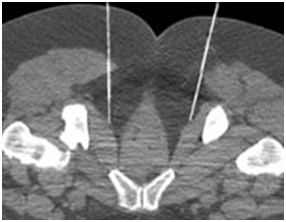| Category | Nerve Blocks |
Pudendal nerve entrapment also known as Alcock canal syndrome is a source of chronic pain in which the pudendal nerve (located in the pelvis) is entrapped or compressed in Alcock's canal.
Pain is positional and is worsened by sitting. Other symptoms include genital numbness, fecal incontinence and urinary incontinence.People may also experience a burning pain in perianal or genital areas
The term pudendal neuralgia (PN) is often used interchangeably with "pudendal nerve entrapment". This condition can greatly affect a persons’ quality of life. Pudendal neuralgia can be caused by many factors including inflammation, extreme cycling, and can be a "secondary condition to childbirth"
PNE is said to be caused by genitoanal surgical scarring and mishaps in the pelvic region, trauma to the pelvis, pregnancy, childbirth, bicycling and anatomic abnormalities
Vaginal birth may lead to pudendal nerve damage from the stretch during delivery and the likelihood increases when delivering larger than average babies.
As the pudendal nerve lies in the pelvic region, surgical procedures that involve this area, such as a cesarean section, can cause nerve injury
PNE can present in cyclists, likely due to both the compression and stretching of the pudendal nerve for prolonged time. Heavy and prolonged bicycling, especially if an inappropriately shaped or incorrectly positioned bicycle seat is used, may eventually thicken the sacrotuberous and/or sacrospinous ligaments and trap the nerve between them, resulting in PNE.
Symptoms
Imaging tests to check for bone fractures, dislocation, other wrist injuries and help rule out other possible conditions such as arthritis. Imaging tests include X-rays, MRIs, CT scans, and
One way to identify and alleviate pain associated with the pudendal nerve is a "CT-guided nerve block
During this procedure, "a long-acting local anestheticand a corticosteroid are injected to provide immediate pudendal anesthesia
A reduction in pain following this injection is typically felt quickly. Relief from chronic pain may be achieved through this procedure due to the reduced inflammation from the steroid medication, and "steroid-induced fat necrosis" which "can reduce inflammation in the region around the nerve" to lessen strain on the pudendal nerve.
The doctor will clean the area over the region of interest and insert a small needle into the target area under imaging guidance. When it is in the correct position, they will inject the drug. They will remove the needle and cover the injection site with a small dressing.
We have very fast and competent working team (Consultant, fellow, clinical assistant, technician and ward assistant) which provide you comfortable atmosphere and ease your nerves. Usual time of stay is few hours
Every procedure carries a risk, although this is extremely small. The risk of infection with this procedure is extremely small as no incisions are made in the skin.
You can resume your work after 1 day if existing disease allows.
